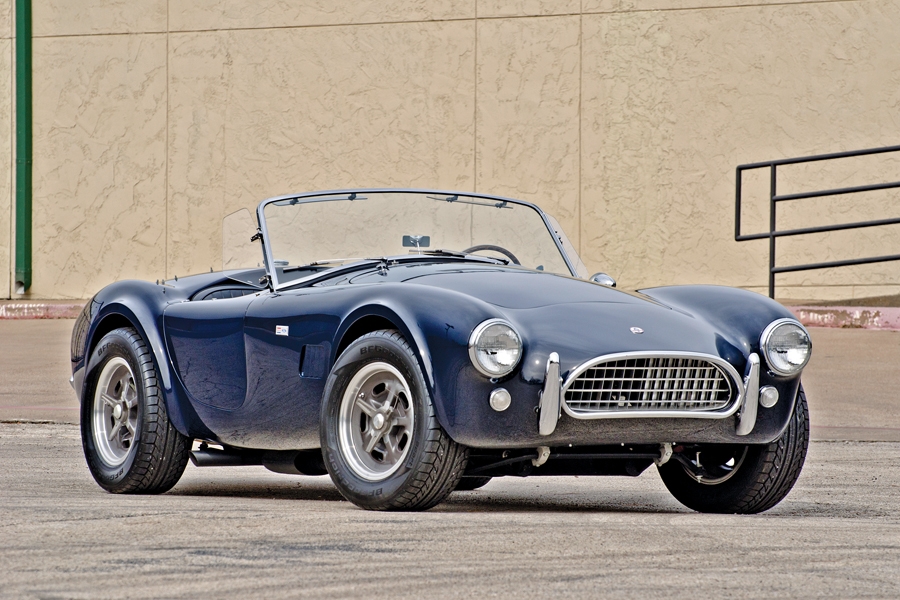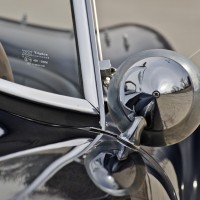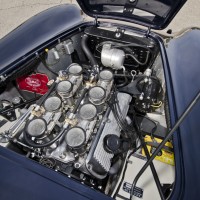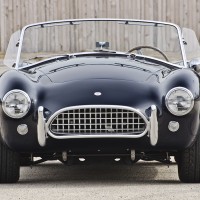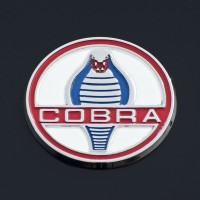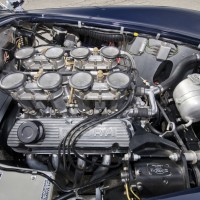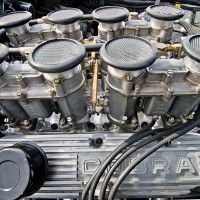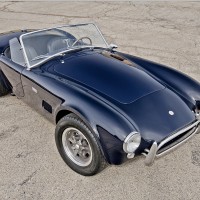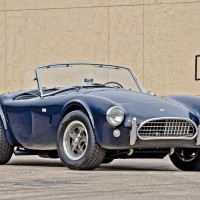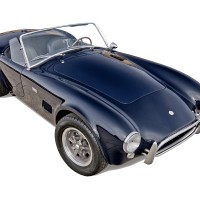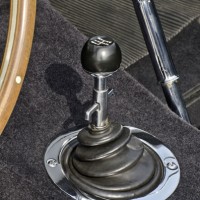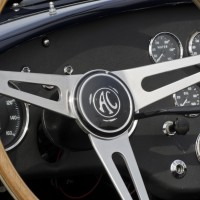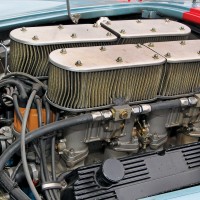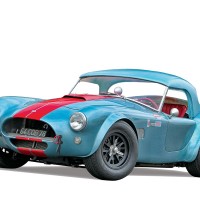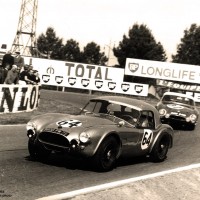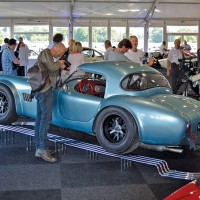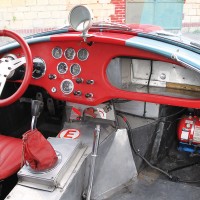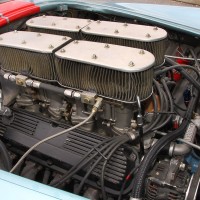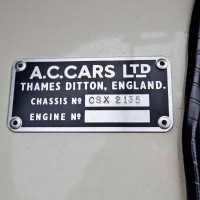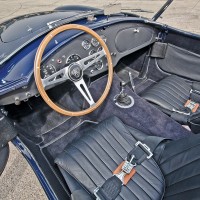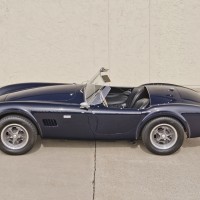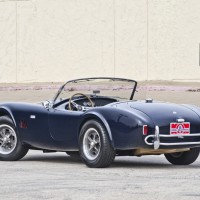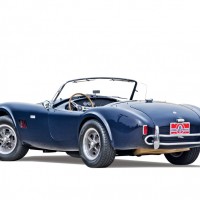Exhibit A: 1963 Shelby 289 Cobra Chassis CSX2135
From the Mecum Auctions description: CSX2135 is one of the first Cobras to employ rack-and-pinion steering. Originally finished in white with a red interior, it arrived in New York on June 27, 1963, aboard the SS American Commander. It was consigned on August 24 to W.J. Janner of Ford Motor Company Car Sales Promotion, Dearborn, MI, and shipped via Shelby American transporter to the FoMoCo district office in Kansas City, MO. On September 16, it was invoiced to Ford executive and future Ford Racing director Jacques Passino, listing the “Class A” accessory group that included chromed 5.5-inch wire wheels with “AC” knockoffs, a dash-mounted rear-view mirror, wind wings, chromed bumperettes and a quick-fill fuel cap, a luggage rack and whitewall tires. Including freight and the Ford discount of $300, the car listed at $5,387. After a busy year of various demonstrator duties in the Kansas City area, the car was returned to Shelby with an odometer reading of 5,300 miles and Ford work order number 1077, which authorized Shelby to recondition it for resale. Shelby completely repainted the car in White Lucite, installed five new six-inch painted wire wheels, new carpets, soft top, side curtains and seat belts, a new windshield, rear bumper overriders and mufflers, all at an estimated cost of $1,125. The completed Cobra was then sold to Beverly Hills Sports Cars on March 31, 1965, at a cost of $4,250 — plus a $10 delivery charge. While its first owner is unknown, it was registered with the California black plate RFG 836. In 1967, it appeared for sale in Walnut Creek, CA, on the Brant Motors used-car lot, where it was purchased by California resident Tom Ellis. In the mid-1970s, Ellis sold the car to Alan T. Lloyd of El Cajon, CA. Lloyd brought 2135 to SAAC 3 in Pasadena in August 1978, by which time it had been repainted in 1966 Ford Emberglo (essentially a metallic Copper color) with twin black stripes and black upholstery. The car’s wheelwell flares, unfortunately finished in brown primer, had been widened from the early version to the later type, designed to accommodate the new wider six-inch wheels installed beginning with CSX2160; front fender side vents had also been installed. After being advertised for sale in 1983 and 1984, the car appeared with Lloyd in the same condition at SAAC 9 at Anaheim in August of 1984. Three months later, Lloyd reported the car stolen. In 1989, CSX2135 reappeared and was purchased by Milton Janzen of San Francisco, who soon realized he had bought a stolen car. He immediately contacted title holders State Farm Insurance, who demanded the car’s immediate return. Instead, Janzen convinced State Farm to sell him the title, which he then registered with plate number 2ZSL192. Janzen then commenced a restoration that included refinishing the Cobra in dark blue paint with a contrasting Saddle leather interior, fitting Weber carburetors and reproduction Halibrand six-spoke knockoff wheels. In June 1993, the car was purchased by John Duffield of Bakersfield, who changed the upholstery to black. The Cobra was advertised for sale and described thus: “CSX2135, 289 hi-po. This car is an original and is beautiful; no-expense-spared restoration completed 4/99. Color is Mercedes Midnight Blue with black leather; rack-and-pinion car with roll bar, sidepipes, Webers and Halibrands. $167,500.” After 35 years in California, CSX2135 found a new home in the hands of Jim Carrolo of Steamboat Springs, CO, who bought it as a regular driver. In 2006, the original 289 HiPo engine was replaced by a 347-ci “fun motor,” and the 289 was placed in storage. Today, CSX2135 presents in beautifully pristine condition, needing nothing to make it completely ready for its new home with a committed Shelby Cobra enthusiast. The original 289-ci engine as well as a set of 5.5-inch Shelby knockoff wire wheels are included with this exceptional and rare early rack-and-pinion demonstration Cobra.SCM Analysis
Detailing
| Vehicle: | 1963 Shelby Cobra 289 roadster |
| Number Produced: | 580 |
| Original List Price: | $5,995 |
| SCM Valuation: | $775,000 to $975,000 |
| Tune Up Cost: | $250 |
| Chassis Number Location: | Tag in engine compartment, hood latch, inside door |
| Engine Number Location: | Left side of engine |
| Club Info: | Shelby American Automobile Club |
| Website: | http://www.saac.com |
| Investment Grade: | A |
CSX2135, Lot S134, sold for $885,000, including buyer’s commission, at Mecum Auctions’ Spring Classic sale in Indianapolis, IN, on May 18, 2014.
A few years ago, $885k for any 289 Cobra would have been headline news, especially for a modified car such as 2135.
The updated fender flares, added fender vents, exterior and interior color change, and a hot-rod 347 stroker motor with Weber carbs under the hood are all things a purist would see as detractions, regardless of how much driving excitement they may offer over the stock configuration.
But in today’s world, a good rack-and-pinion 289 Cobra is very tough to find at any price, let alone under six figures. And what 2135 does possess, as they say, is good “bones.” It is a Cobra with a well-documented and continuous history from new, with a short list of caring, enthusiast owners.
It was indeed used as a Shelby and Ford PR car when new, assigned to Jacques Passino, an important figure in Ford Motorsports history and a nice name to have on the résumé. And, Cobras being the simple machines they are, as 2135 came with its original engine and other bits, you’d be hard-pressed to spend more than 10% of the hammer price here to put the car back to as-delivered condition and specification if so desired. This means the $885k Mecum sale price leaves the buyer plenty of options for CSX2135, none of which involve submerging in financial water.
Exhibit B: 1964 AC Cobra Chassis COX6010
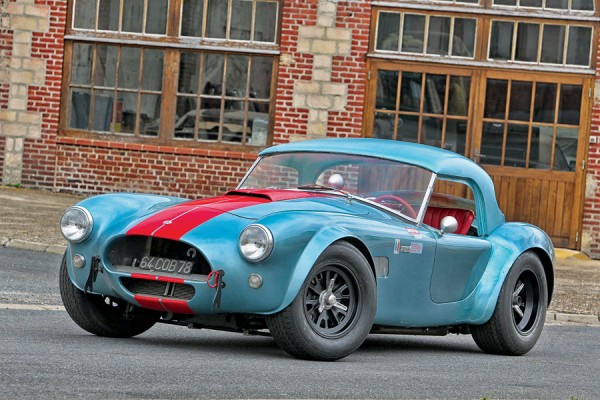
From the Artcurial auction description:
COX6010 was delivered to the official French marque importer, Établissements Chardonnet, in Pantin near Paris, on March 19, 1964. COX6010 was liveried in Princess Blue with red leather interior. On April 2, 1964, it was acquired by Count Jean de Montemart, although it was Chardonnet who entered the car for the 1964 Le Mans 24 Hours. As Count de Montemart bought the car on 2 April, the race entry was actually in his name with Régis Fraissinet. These gentlemen proved equal to the challenge and finished the race in 18th place.
Montemart had an accident later on and sold the car to Jean Marie Vincent. The car remained with him for a few years as he continued to race Cobras. He owned CSX2001, CSX2142 and COX6010 at the same time. He fixed the front of the car using the first front quarter of the frame taken from CSX2142 and made an ugly-but-convenient fiberglass front bonnet and continued to race. After some time, the car was found untended in a private car park and as the rent had not been paid, the owner called the gendarmerie and the car was towed away to a junkyard near Paris.
Bernard Maitre bought it straight away for 250 francs. This gentleman was the co-founder with Jacques Lavost of the AC Automobile Club in France in 1967 and more recently, consultant for the FIA and FFSA for historic racing cars. A great AC enthusiast, he saved the car from being destroyed. The car was in poor condition but pretty much complete — apart from the engine (a 289-ci block was sitting on the passenger’s side) and the missing wheels. Maitre remembers that the car had the serial numbers 6010 stamped on the doors and on the trunk
He sold it in August 1969 to Bernard Alter, who was in the process of restoring COX6002, another French Cobra. Bernard Afchain registered COX6010 in his name on September 15, 1974, and undertook a complete restoration. As the chassis was damaged, he ordered a chassis from David Sanderson in England, and had his original chassis number stamped on it.
The car underwent certain modifications mechanically and to the body, which was made by Brian Angliss. The bodywork was renewed during this restoration, and it is interesting to note that the interior of the doors, bonnet and boot-lid have the original paint, and the series number 6010 is stamped on all these opening parts. They even show some of the white paint along the tubing. The bonnet with 6010 stamped on it was bought back later from JM Vincent to complete the restoration. The interior of the right door still shows the location of the light (now covered) used to illuminate the racing number for the timekeepers at night. It comes with its side screens and the original red leather internal door handle, as well as the original gearbox and the rear axle (on the side).
This is a highly important Cobra. Its history was made at the legendary Le Mans 24 Hours. COX6010 and its list of options and modifications are recorded in the Shelby American World Registry. It has belonged to the current owner since 1985 and was restored the right way. It shows a very nice patina and runs very strong.”
COX6010, Lot 240, sold for $1,033,992, including buyer’s premium, at Artcurial’s Le Mans Auction in Le Mans, France, on July 5, 2014.
The above is an edited version of Artcurial’s catalog copy; I assure you in its entirety the story is no less confusing. I’m going to classify the written account of COX6010’s life as the hamburger method of delivering bad news. In this case, start out with the great original specification and the Le Mans effort as the tasty crown of the (brioche?) bun, throw in that COX6010 was largely destroyed in the 1960s and left for dead as our protein (covered in cheese and other accoutrements) — and then finish with COX6010’s subsequent resurrection and recent history as the solid (brioche?) heel.
While most people would be distracted with the beautiful bakery, nice presentation, and side of (French?) fries, I read the history and smelled some bad meat. Digging into my SAAC World Registry, the footnotes for COX6010 agreed with Artcurial’s text — minus the burger.
I immediately thought the Le Mans history of COX6010 wasn’t something that should have transferred to a new chassis, a new body, and a new drivetrain built for current-day competition in Europe.
At best, the description leads one to the conclusion that the only part of the car Artcurial sold with ties to Le Mans 1964 may be the doors, hood, and trunk lid, but based on the photos of COX6010 as found in the scrapyard, even that may be a stretch.
However, I don’t want to unfairly judge any Cobra — especially one with ties to Le Mans. I rang up Ned Scudder, SAAC’s Cobra Registrar, to get his take on COX6010.
Ned, never at a loss for words, had this to say: “6010 was parted out in the rebuild of CSX2142, leaving just paperwork behind. That paperwork was transformed into a brand-new automobile in 2000, which was some 35 years after the construction of the original. The new chassis was built by David Sanderson, and Brian Angliss provided the new FIA bodywork. It has a new 289 engine and completely new ancillaries. Hence, it is really no longer a Cobra with any connection to Thames Ditton, which seriously challenges its value, and the serial number’s competition history should remain separated from the newly built car.”
Well, that answers that. Another Competition Cobra that raises the same question as Theseus’ Paradox?
Another item worth noting with the sale of COX6010 is that of its chassis number. CSX (C= third Ace series, S= Shelby, X= LHD eXport) chassis number cars, the prefix that identifies Shelby Cobras that were built at Shelby American in California from 1962 to 1967, typically hold an edge in value to the COB (CObra Britain — AC home market cars in RHD) and COX (CObra eXport — LHD cars built for the rest of the European market) cars, which were essentially built under license from Shelby for “rest of world” consumption, completed at AC Cars in England, and not called “Shelby Cobras” but rather “AC Cobra 289s.” This edge in value for CSX chassis cars is much more pronounced on this side of the pond for obvious reasons.
The verdict
Had both of these Cobras been in the condition of CSX2135, which is to say, used, lightly modified, but with their original chassis, aluminum skins, and drivetrains, the sales results clearly wouldn’t be so close — nor would our ability to clearly pick a winner in this face-off.
If COX6010 had kept more of its original DNA — and even sold for twice what CSX2135 did, it still could have been the better deal. That said, I do not think I am alone in having a hard time carrying forth the value of being an original Comp car and the Le Mans 1964 finish to the Artcurial sale at Le Mans in 2014 for COX6010.
Therefore, between these two Cobras — after weighing history, chassis numbers, and originality — I call the sale of CSX2135 as a completely market-correct sale that was fair to both buyer and seller, and call COX6010 extremely well sold, or as SAAC’s Ned Scudder said: “The seller of COX6010 lucky? Incredibly so!” ♦
